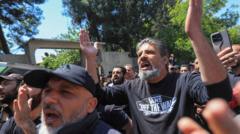In the shadow of Syria's ongoing conflict, the Druze community, known for its unique beliefs, grapples with newfound fears of violence and isolation. The unsettling atmosphere stemmed from recent sectarian clashes, particularly in the Damascus suburb of Ashrafiyat Sahnaya, where locals like Lama al-Hassanieh experienced firsthand the terror of gunfire and extremist threats.
As she sheltered in her bathroom, bullets rang out and militants, clad in military attire, shouted threats against Druze residents. "Jihad against Druze" echoed ominously in the air, leaving Lama and her community feeling exposed and vulnerable. Historically aligned with the Syrian state under President Bashar al-Assad, the Druze now question their safety following a series of violent incidents ostensibly connected to religious extremists.
In April, a fabricated audio recording involving a Druze leader sparked violence that left over 100 dead, including civilians and members of the community's own militia. The government responded to the unrest, citing the need to restore order, but many Druze argue they are gradually being sidelined and their needs overlooked in a Sunni-dominated landscape.
Fellow student, Lama Zahereddine, recalls the harrowing shift in her surroundings as violence encroached upon her village, pushing residents into desperate situations. With unarmed men battling against well-armed aggressors, the community's fear escalated. Reports of assaults on Druze students at universities further compounded their sense of danger.
Distrust in the government, which many believe has failed to protect its citizens, is widespread among the Druze. With social interactions shifting and previous alliances strained, some members feel increasingly marginalized, questioning their status as equal citizens. Hadi Abou Hassoun, a local Druze, expressed his yearning for a justice system that upholds the rights of all citizens, emphasizing that today's lawless conditions contradict the principles of a fair state.
Outside interference further complicates the situation, with Israel conducting airstrikes, claiming to protect the Druze from threats. However, the fragile calm in Ashrafiyat Sahnaya still carries an air of suspicion, as residents navigate a landscape forever altered by violence and uncertainty.
With trust eroded and a longing for recognition as equal Syrians, Lama and her neighbors continue to seek assurance from their government and a safer future for their community amidst a turbulent backdrop of sectarian strife.
As she sheltered in her bathroom, bullets rang out and militants, clad in military attire, shouted threats against Druze residents. "Jihad against Druze" echoed ominously in the air, leaving Lama and her community feeling exposed and vulnerable. Historically aligned with the Syrian state under President Bashar al-Assad, the Druze now question their safety following a series of violent incidents ostensibly connected to religious extremists.
In April, a fabricated audio recording involving a Druze leader sparked violence that left over 100 dead, including civilians and members of the community's own militia. The government responded to the unrest, citing the need to restore order, but many Druze argue they are gradually being sidelined and their needs overlooked in a Sunni-dominated landscape.
Fellow student, Lama Zahereddine, recalls the harrowing shift in her surroundings as violence encroached upon her village, pushing residents into desperate situations. With unarmed men battling against well-armed aggressors, the community's fear escalated. Reports of assaults on Druze students at universities further compounded their sense of danger.
Distrust in the government, which many believe has failed to protect its citizens, is widespread among the Druze. With social interactions shifting and previous alliances strained, some members feel increasingly marginalized, questioning their status as equal citizens. Hadi Abou Hassoun, a local Druze, expressed his yearning for a justice system that upholds the rights of all citizens, emphasizing that today's lawless conditions contradict the principles of a fair state.
Outside interference further complicates the situation, with Israel conducting airstrikes, claiming to protect the Druze from threats. However, the fragile calm in Ashrafiyat Sahnaya still carries an air of suspicion, as residents navigate a landscape forever altered by violence and uncertainty.
With trust eroded and a longing for recognition as equal Syrians, Lama and her neighbors continue to seek assurance from their government and a safer future for their community amidst a turbulent backdrop of sectarian strife.



















